While trekking in the Himalayas with a bunch of strangers, we learnt that sometimes, the best way to find yourself is amidst gentle giants
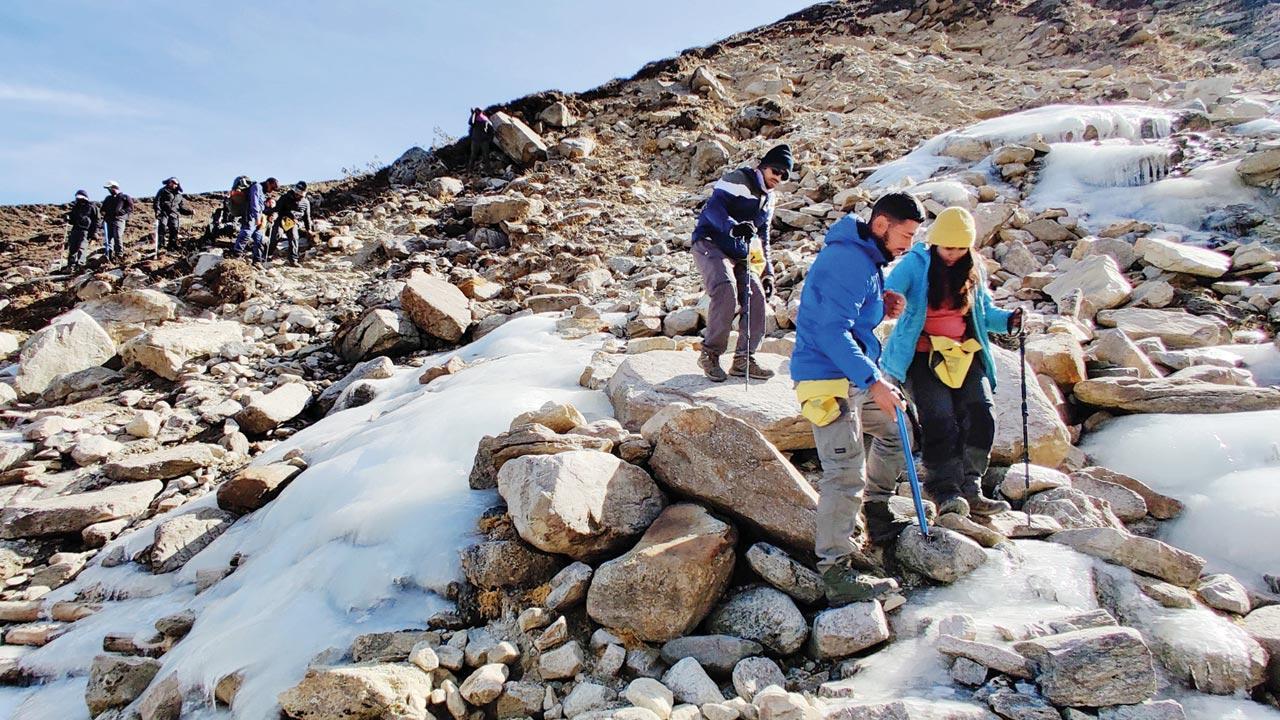
The toughest part of the trail was crossing a glacial mountain stretch—one had to be careful about avoiding the ice, placing our feet on the rocks, as we could risk falling right down
Adventure
Tour & taste
Relaxing
Educational
Ancient & historical
It's on Marine Drive, drenched by an unexpected shower, that I made up my mind—almost—to go to the mountains, and alone. I cannot remember now, if it was the rain, or my foggy mind, my instinct, or a conversation with a close friend who had just returned from a similar trip that triggered this decision. But, less than 72 hours later, I had booked myself for a four-day trek to Kuari Pass in the northeastern region of Garhwal, Uttarakhand. At the outset, I must confess that I didn’t think this plan through. The reason I chose Kuari was because it was the only “pretty” and “easy” winter trail that caught my attention on Indiahikes, the Bengaluru-based trekking organisation, where I had made the booking. The planning followed.
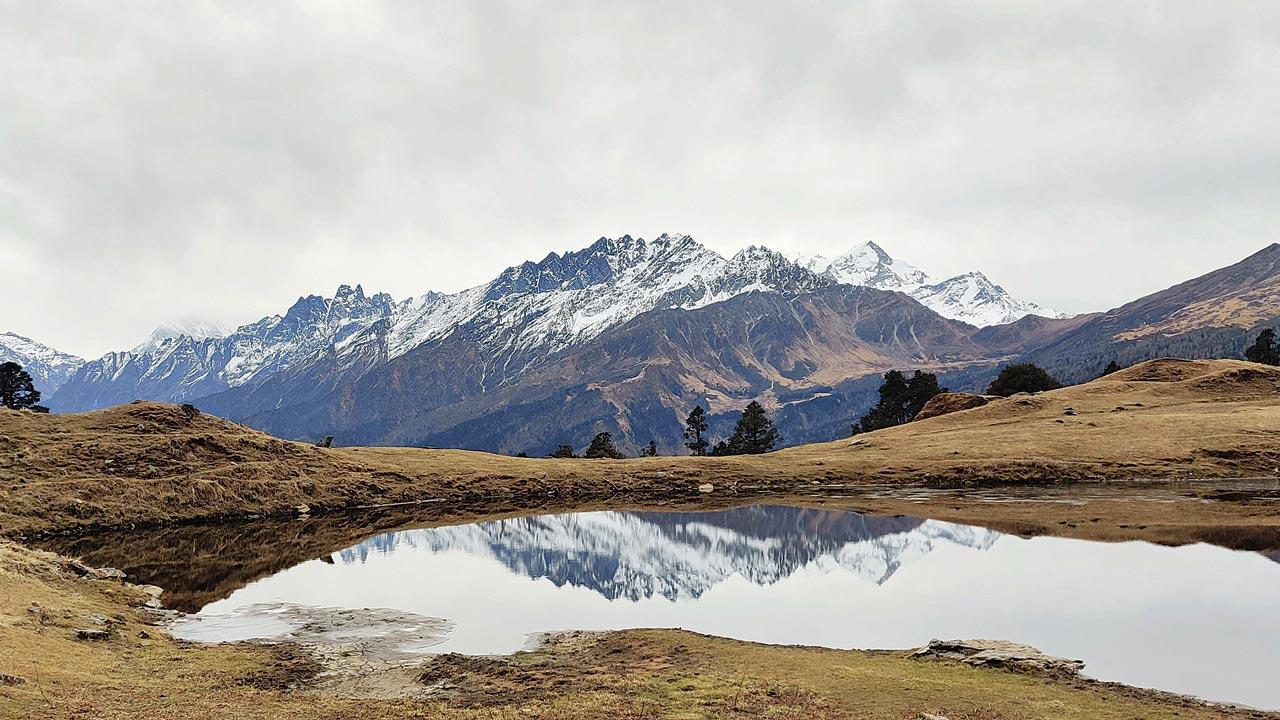 Akhrotghetta (9,265 ft) has one of the most breathtaking views of the snow-capped Mt Dronagiri—the massive walnut tree, lying barren in the autumn cold, was the perfect foreground
Akhrotghetta (9,265 ft) has one of the most breathtaking views of the snow-capped Mt Dronagiri—the massive walnut tree, lying barren in the autumn cold, was the perfect foreground
Since a compressed nerve in my lower back has been a looming concern, and I was travelling solo, I didn’t want to jeopardise the trek. I had two months to up my fitness levels (cover 5 km in 38 minutes), and prepare for the trip, which included shopping and renting trekking gear. I opted for the latter and also borrowed from friends, because investing in expensive gear, unless you are sure about wanting to do this again, isn’t wise. I guess, it paid off, because there I was, amidst the Himalayas, on November 26, never more confident about what I was doing.
The Kuari pass trek is one of the rare Himalayan trails that offers up, close and personal views of Mt Dronagiri (23,182 feet) and Mt Nanda Devi (25,673 feet). It’s also among the few trekkable mountain passes in the winter—yes, you can trek in snow, too. Our meeting point was Rishikesh, from where we had a nine-hour-long drive to Tapoban (7,313 ft), our base. I remember my initial jitteriness about being on my own, but this was immediately quelled by the people I met. We were together in this for the next four days.
 Tali lake, perhaps the most photographed site in Kuari, reflects the mountains in its full glory. The lake leads to an overhanging ridge trail, cutting through a cliff, which is also one of the more frightening stretches to walk through. Pics/Jane Borges
Tali lake, perhaps the most photographed site in Kuari, reflects the mountains in its full glory. The lake leads to an overhanging ridge trail, cutting through a cliff, which is also one of the more frightening stretches to walk through. Pics/Jane Borges
The real leg work began on the second day. After an overnight stay at a lodge in Tapoban, we made a dash for Karchi (7,550 ft). Blood pressure and oxygen levels checked, our trek leader, Manthan Pandya, who incidentally took a break from his family business in Mumbai to take on the mountains, along with two other local guides, Jaideep Bhatt and Suraj Negi, led us through the stretch. Before we began, Pandya gave us a quick primer on how the body responds to high altitude (anything above 4,900 ft from sea level)—breathing becomes faster, pulse rate increases, blood becomes thicker, we sleep less, and urinate more. This is because, at a high altitude the air pressure drops drastically, decreasing the partial pressure of oxygen. This is also why we don’t wear masks on such treks. There’s also a risk of picking up Acute Mountain Sickness (AMS)—the symptoms include dizziness, headache, muscle aches and nausea. A preventive course of Diamox, an oral tablet, is usually given to trekkers, whose oxygen levels drop severely—ours was monitored thrice a day.
On that day, we were only going to cover 2.5 km, but the continuous ascents made this trail anything, but easy. In fact, the initial 20 minutes was the toughest. We reached our first campsite, Akhrotghetta (9,265 ft), meaning farm of walnuts, five hours later, right in time for lunch. It also offered one of the most breathtaking views of the snow-capped Mt Dronagiri—the massive walnut tree, lying barren in the autumn cold, was the perfect foreground. Each campsite has tents that can accommodate two or three people, spread out through the site. There’s also a kitchen tent where hot meals are prepared, a dining tent where campers meet for meals, and two bio toilets—deep pits dug inside the ground. The deep pits are a more environment-friendly option—in sync with Indiahikes sustainable goals—as they protect the topsoil from permanent damage, and if managed well, can make the soil richer.
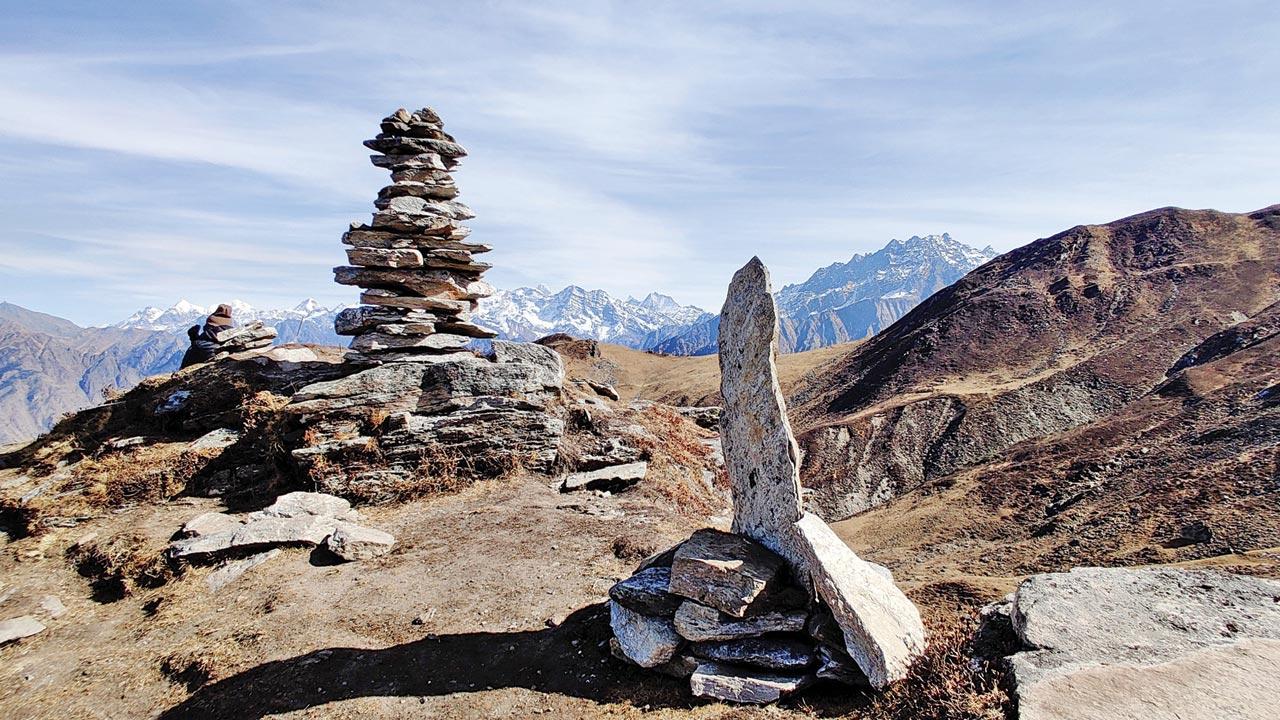
The Kuari Pass summit offers sweeping sights of the Chaukhamba, Neelkanth, Dronagiri, Nilgiri and Hathi Ghoda peaks
While mornings are warm, temperatures drop drastically after the sun escapes the mountains. At Akhrotghetta, the sun left us by 3 pm, and we had no option but to layer up. We were advised to wear a full sleeves T-shirt and a fleece jacket (padded jackets too, if it gets cooler) while trekking. In the nights, thermals are a must, followed by the same layering—you may need to add a sweater or two, to this mix.
I have vivid memories of that day for more reasons than one. We were all expected to share our tent with someone, because in case of an emergency, especially in the middle of the night, it’s always best to have company. A couple, who was celebrating their anniversary in the Himalayas, willingly swapped with another solo trekker and me. Their kindness put me at ease. Later, when we gathered for tea in the dining tent, the local guide, Bhatt, regaled us with legends and lore from the mountains, many of which scared the wits out of us, but, we continued to listen. I had heard of the famed raconteurs, but it was the first time I was witnessing one. His stories were unarguably what many of us, including this writer, enjoyed coming back to, after a long day trudging through the wilderness. After dinner, some of us spent that night—the only bearably cold campsite over the next four days—trying to retrace constellations under the starry blanket or dabbling in astrophotography. We saw many a shooting star; I’m sure a lot of wishes echoed back to the sky that day. The entire experience was surreal. I was not in the midst of friends, but, in a first, I didn’t feel alone.
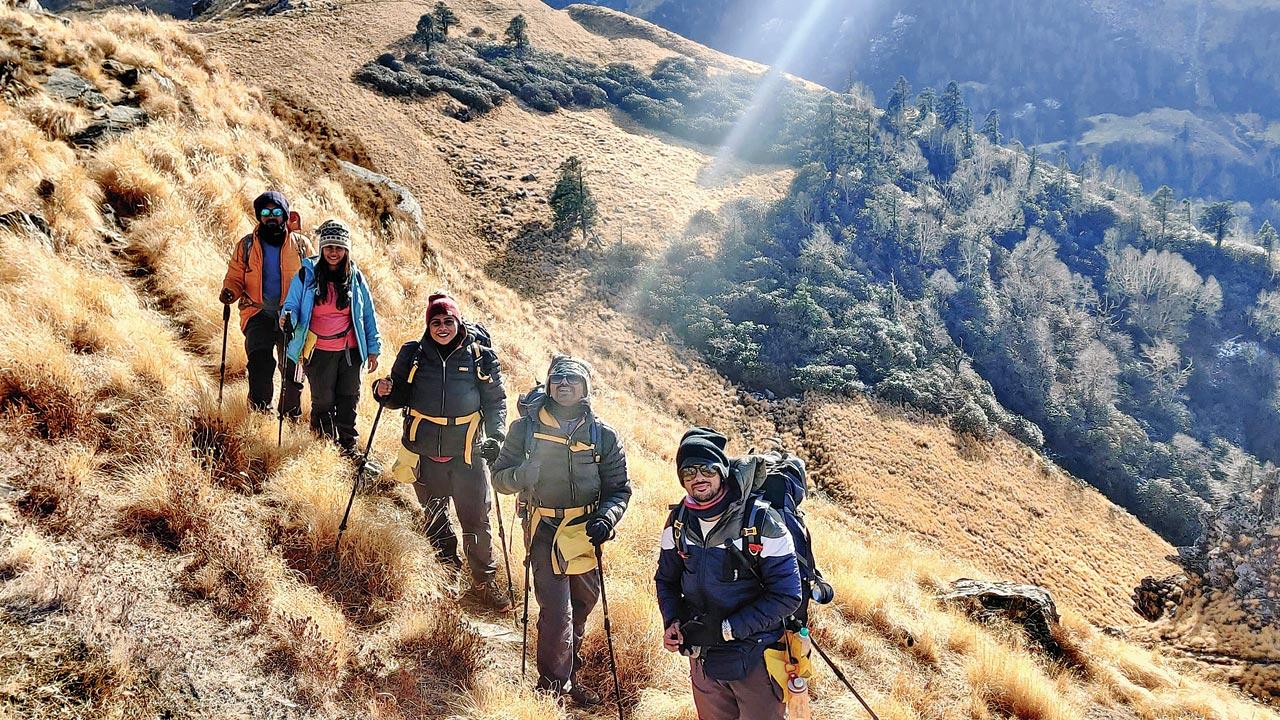 After completing the summit, we walked along a ridge, reaching Jhandi Top, where there are more spectacular views of the mountains. From here, we descended towards the Chitrakantha meadows
After completing the summit, we walked along a ridge, reaching Jhandi Top, where there are more spectacular views of the mountains. From here, we descended towards the Chitrakantha meadows
We covered a similar trail the next day, each of us hugging a tree and sharing our deepest secrets with it, before reaching Khullara (11,014 ft) by afternoon. We were forewarned about how cold it was going to be at this campsite—apparently, coldest in the Uttarakhand region, dreaded even by the locals. It was here that I first understood what biting cold feels like. Since lighting a camp fire is banned in the mountains, we all struggled keeping ourselves warm. Our only resort was huddling together in the dining tent; we left only when it was time to sleep, two sleeping bags in tow.
On summit day, we started early by 7.30 am, as there were predictions of rain, which if struck, would have made the route slippery. The trail began with a steep climb along the tree line, followed by a ridge walk, which is a part of Lord Curzon’s trail—named after the former Viceroy of India, who was a keen trekker, and discovered this route. The toughest part here was crossing a glacial mountain—we had to be careful about avoiding the ice, placing our feet on the rocks, as we could risk falling right down. The summit (12,516 ft) was gorgeous, offering sweeping sights of the Chaukhamba, Neelkanth, Dronagiri, Nilgiri and Hathi Ghoda peaks. A part of me was exhausted. If I was feeling any strain, it was from walking with my backpack, but the mountains teach you very quickly to carry your albatross. We had another five hours before we could reach our next campsite, Tali (10,889 ft), also the most green spot, right in the heart of a forest, with a stream not too far.
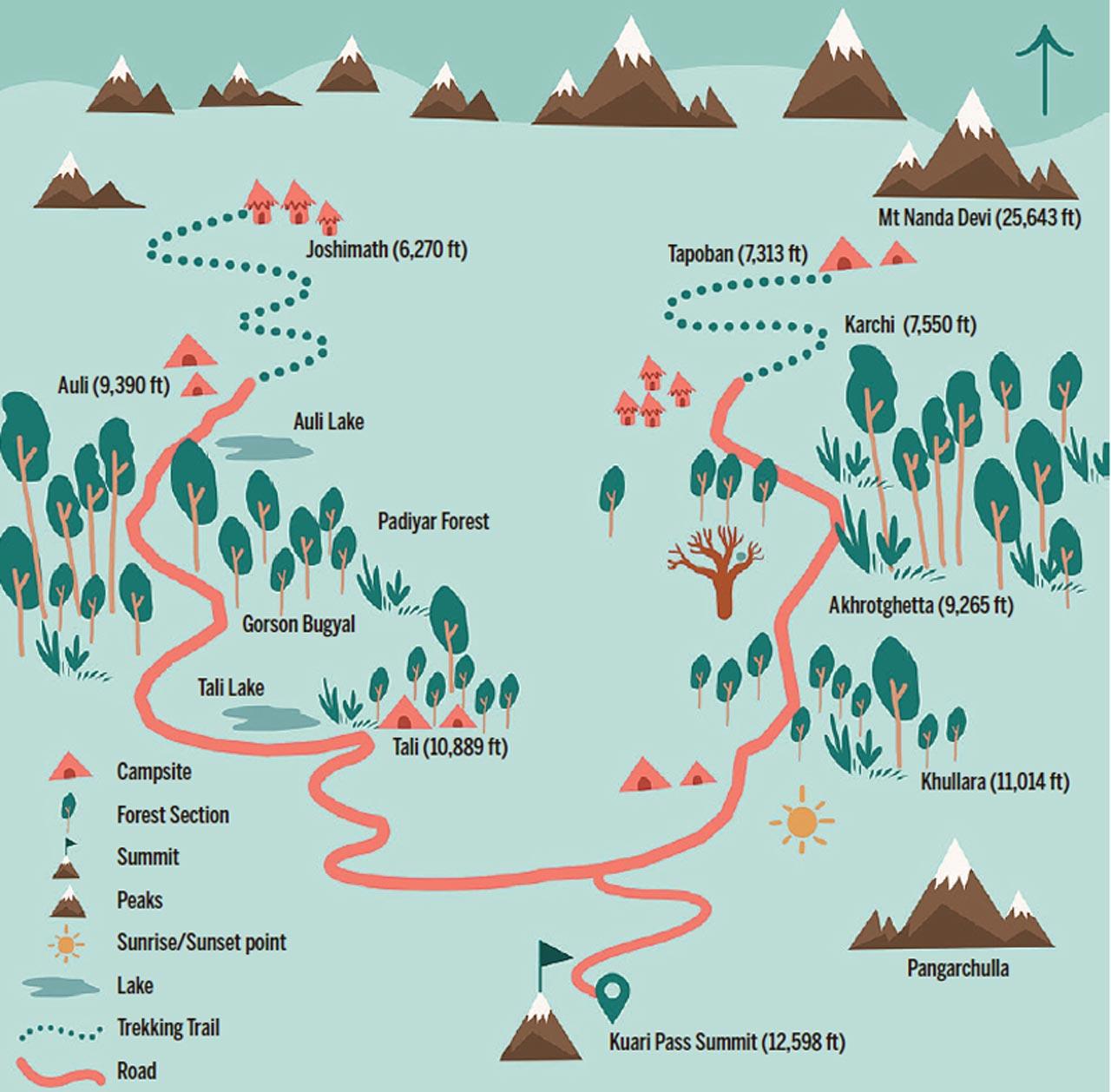
Illustration/Uday Mohite
We headed for our last destination, Auli, which was another 8 km away, the following day. One of the most beautiful sights here was Tali Lake that reflected the mountains in its full glory. The lake led to an overhanging ridge trail, cutting through a cliff, which was also one of the more frightening stretches, because of how narrow it was. I had my heart in my mouth throughout the climb—the weight of my backpack made it slightly strenuous. My trek leader Pandya offered to carry my bag once too many, but I was determined to do this with little help. That trail ended at Gorson Bugyal, opening us up to expansive views of rolling meadows. We reached Auli by early evening that day. This town turns into a winter wonderland after it snows, and is one of the most popular ski destinations in the country. We were still two days shy of witnessing snowfall in the region, and that’s probably my only regret. It’s also another excuse to return to Auli, and tie those loose ends.
But, finally we were done, exhausted yet exhilarated after four days of endless walking. The Internet finally back, we were now sealing the connections we made in the mountains, with virtual “friend requests” and “follows”. Somewhere in the distance, Mt Nanda Devi was staring back at us. At that time, I remember feeling only gratitude for being there. I had gone to the Himalayas as a lost soul, trying to find purpose in the chaos of life in the city. Having experienced the simple life, I returned liberated, but not yet found. A part of me is still stuck somewhere, perhaps in the dining tent, where we shared stories and made friends with strangers, or maybe the ridge, where I conquered many of my fears.
4
No. of days it takes to cover Kuari stretch
How to reach the basecamp
Book your air/train ticket to Delhi or Dehradun. Take a vehicle from Rishikesh to Tapoban, where you stay for the night. Drive from Tapoban to Karchi.
3 words of advice for a first-time trekker
Get fit for the trek: Best to start with a fitness routine around two months before the trip, which includes jogging 3-5 km, strength training (squats, lunges or regular gym), HIIT workouts, cycling and staircase climbing.
Don’t over-pack: If you are carrying your backpack on the trek—Indiahikes has an option to offload—it’s best to travel light. Carry enough for the number of days you will be trekking, prioritising basics.
Be prepared for eventualities: Anything can happen in the mountains. You could pick up AMS or might get caught in heavy rain or a blizzard. The local trek guides are always mindful about the changing weather patterns, and suggest alternative routes, or returning to base camp. Don’t lose heart if that happens. You can always come back and complete the trek again.
Want to hear from you
We are looking to visit and write about interesting places of stay and travel, near and far. If you wish to host us for a fair, engaging experience review, write to us at smdmail@mid-day.com
 Subscribe today by clicking the link and stay updated with the latest news!" Click here!
Subscribe today by clicking the link and stay updated with the latest news!" Click here!










